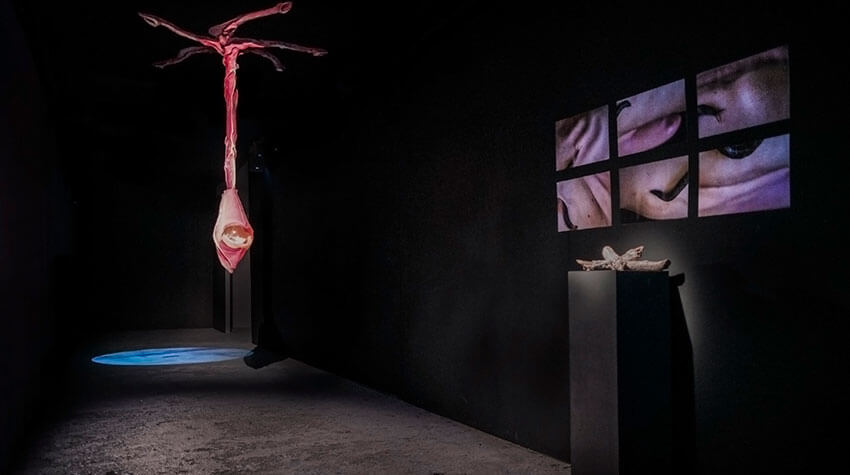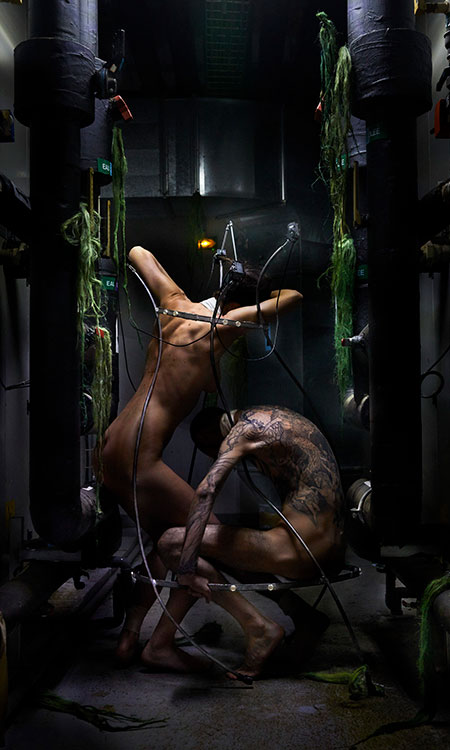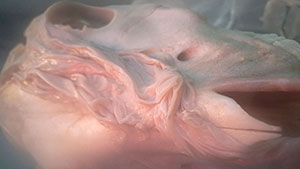Interview Živa Brglez

Art practices that employ biological cells, tissues and organisms, habitually called “bioart”, are artistically most significant not because of their “usage” of these kinds of material – not, for example, because one can and would grow a painting – but because they effectively encroach and disrupt biopolitical and/or bioethical realms in meaningful and remarkable ways. Often, these kinds of practices are bold and forward-thinking; sometimes, they are poetic. Margherita Pevere’s work checks all of these boxes.
Margherita Pevere is an artist and researcher based between Berlin and Helsinki’s Aalto University, where she is a PhD candidate in Artistic Research. She says she has a “visceral fascination for biological matter” and calls bacteria, animals and plants not materials but “allies in the exploration of the underlying theme of ecological complexity”. She views them as kind-of equals, certainly as equally worthy of attention, as she has indicated in her work Reliquiarium (2011), a collection of carefully framed relics of animal and plant limbs. Her utterly respectful and cherishing attitude to the bio-world can further be grasped from Herbarium (2012), a series of botanical tables that reveal plants’ poetic afterlives, being transformed with insects, microorganisms and the like over time.
With her later works, she held on to the intimate poetics of the early works and added to the complexity of her artistic expression. As she explains, the “leaky character” of the biomatter is precisely what fascinates her. It represents something that cannot be fully controlled, something that defies borders, something undisciplined, open. Traces of it can be found in Lymph, an installation in which a mixture of blood meal and caput mortum pigment slowly dribbles on a cotton cloth which is hanging from a ceiling.
This performative moment of an uncontained conglomeration of fear, disgust and discomfort pouring over the cloth/culture, tackling cultural appropriations and symbolizations of nature through deeply embedded psychological pathologies may be seen as an attempt to lay bare and resolve the exact polarisation problem that is later addressed with the “leakiness” as an artistic method. Through Semina Aeternitatis, she has been researching the interplay between the body, its genetic information and memory, and conceptualized DNA as a possible memory storage facility. By creating a bacteria that is carrying a memory of an anonymous woman, she called into question our understanding of stability and ephemerality: what would it mean if memory could be preserved forever and – what is more – in someone else’s body?
Wombs is another project that heavily relies on biotechnology as a tool of intervention into biomatter. The project’s vantage point was Pevere’s own experience taking hormonal contraceptive pills, which with the many effects, are making her a “biochemical cyborg”, as she stated. She created an environment, a “hybrid ecosystem” in which her own vaginal epithelial cells and slug egg cells chemically communicated. Slugs, which are, among other things, famous for their hermaphroditic properties, were thus an advantageous organism for comparison on how different cells react to hormonal contraceptives. And, for posing questions of biochemical relationships between the organisms mediated through sexuality and hormonal contraceptives, along with their environmental consequences.
Margherita Pevere’s body of work is thus one of the fine examples of artistic investigations of mechanisms of symbolization, notions of desire, fear and body, ecology, biopolitics and bio/tech ethics, entwined with performative qualities of biological matter.


Right: Humane Methods, Marco Donnarumma x Margherita Pevere (2019). Photo credit: by Manuel Vason
For our audience that is not familiar with your work, could you tell us a bit about your background and what were the origins of your interest in biology and art?
I am a visual artist and researcher with a visceral fascination with biological matter. My work is situated at the junction of biological arts (or “bioart”) and performance. My studio and my home are in Berlin, but I am currently a PhD candidate at Aalto University, Helsinki (Finland) in Artistic Research. I grew up on the Northern Adriatic coast in Italy and have been going back and forth to Berlin since the early 2000s until when I moved there six years ago.
My background is quite transdisciplinary. Before starting my art studies, I gained a BA in Political Sciences with a focus on the environment. I then obtained my MFA in arts and new media at a conservatory. There, I learnt to work with artists from other disciplines, developed a hacking attitude towards technology, and experimented with interactive installations, videos, and performances.
My interest in biology and art has multiple origins. Biological processes have seduced my curiosity since the early years, although it was never “scientific” in the common understanding of the term. Rather, what drove me was a curiosity for bodies and relationships, which I cultivated with other-than-human friends: horses, bees, plants, dogs, and birds. I learnt from them probably at least as much as I learnt from humans through verbal language. My first crush – I was more or less 6 years old – was a donkey colt that happened to be in my village with a circus. I would visit him every day and was so brokenhearted when he left. I also loved to spend my afternoons at the workshop of the local taxidermist and watch him work.
I have no formal training in biology. Besides individual studies, I owe a lot to Biofilia | Base for Biological Arts at Aalto University, the scientists I worked with, and the citizen science and DIYbio scene in Berlin. Quite early, my curiosity for the biological process was harnessed with a critical attitude about how we humans in the global North inhabit our environment. It is a multifold interest that embraces both observations at a higher level of as global phenomena, landscapes, biotopes, as well as a more embodied, immediate interaction with the brute materiality of life.
In both works, Semina Aeternitatis and Wombs, you mention the term ‘leaky’ to describe your projects. Can you describe how you identify with the term ‘leaky’ when speaking about your artwork?
The term “leaky” emerges from the observation of biological matter. Biomatter can get contaminated, grow too little or too much, attract parasites, and die. There is inherent instability and liveliness. There is always something that can not be fully controlled, something that defies borders. Something undisciplined, open. This open, leaky character fascinates me: the closer you look at it, the more open it becomes – which is generative both at the level of artistic practice as well at a philosophical level.
The term refers then to a lineage of feminist scholars who question the idea of the body as an entity self-enclosed, autonomous, stopping at the skin. Liberal humanist thought is built on binaries such as nature vs culture or death vs life, where identities and bodies have clear boundaries. Leakiness, instead, speaks for relationships and interpenetration. Phenomena are not given categories but emerge from a complex of natural, cultural, and technological factors, from the specific way those come together and are observed.
Margrit Schildrick’s book “Leaky bodies and boundaries” and “Embodying the Monster” have been particularly inspiring to me in this regard. Within this lineage, philosopher Marietta Radomska looks closely at how bioart exposes life as uncontainable: uncontainable is the process that is observed, uncontainable the matter of the artwork and the relationships it triggers. Bioart operates in an in-between space.
With regard to my artworks, as I said earlier, the term emerges from the practice itself. It emerges from the “material” I use, the bodies I am implicated with. In Semina Aeternitatis, leaky refers to the evanescence of memory, the paradox of inscribing a story into a body, the genetic procedures used in the project, and the materiality of microbial biofilm.
In Wombs, leaky refers to the porosity of my body, how its mucous cavities are modulated by hormonal contraceptives, how these contraceptives traverse my body and operate in it, exit it and flow into the environment, and how they may interact with other organisms. In the piece, I tried to establish a relationship with terrestrial slugs. Science is still unresolved on how gastropods such as slugs and snails may be affected by mammalian sex hormones, although some research suggests so. Therefore, it is not possible to make claims at the moment. Wombs manifests as an installation with epithelial cells from my body and slug cells and a photographic series.
If you extend the idea of “leaky” beyond the “human” body, it may help you think about interpenetration and relationships from an environmental perspective. I think each one of us should know what plants and animals inhabit the ecosystem we live in – both endemic and exotic. Once we are familiar with what other species share in our ecosystem with us, we may ask how culture (and technology) intervene in this co-existence. Why is that important? Because it helps us think beyond given categories, it trains observation and makes us aware of what relationships shape the world we live in.
It would be a good starting point to understand complex phenomena such as biodiversity loss or climate crisis. I usually begin my artist talks by asking the audience to name 10 local species on the spot. We start the discussion from there. Leakiness opens an enigma, and I, as an artist, look into it.
In Semina Aeternitatis, the work’s narrative is shown through DNA, memory, and biofilm as a means to express transience and immortality. What do you think is the relationship between biological components (DNA, biofilm) and memory?
In Semina Aeternitatis, there is a hybrid creature that carries, in its own body, an old lady’s childhood memory. This is possible thanks to the translation of the transcript of the lady’s memory from the alphabet to a sequence of nucleotides (DNA) via a custom algorithm created by Prof. Mirela Alistar. The resulting DNA sequence was manufactured and, through special bio-protocols, mounted on a plasmid. Plasmids are circular DNA strings found in bacteria.
We then inserted our plasmid into bacterial bodies through genetic editing procedures. We worked with a particular bacteria that produce a biofilm that resembles skin and body matter – a material that is present in some of my recent works. The biofilm in the installation of Semina Aeternitatis is sterilized and retains traces of the lady’s memory in bacterial bodies.
The old lady’s memory goes back to a formative childhood experience: as a five-year-old girl, she was sent home alone from the work field riding the family workhorse. The girl was initially shocked but had to face her own fears and learn to trust herself and the horse. The mild stubbornness of the horse’s trot and her own self-reliance became a lifelong lesson for the girl.
Other artists have worked with DNA encoding in vivo before – think of Microvenus by Joe Davis or Genesis by Eduardo Kac. For Semina Aeternitatis it was crucial to embrace something vulnerable as individual memories rather than a text considered “universally” important. It is the vulnerable and evanescent character of individual memories that exposes transience and temporality in the piece.
Theoretically, the text encoded in the DNA string may be readable in a faraway future from now – if the encryption algorithm is still available and, depending on how bacteria are preserved alive in the lab, may modify the DNA string. Because of this possible faraway future, the childhood story of the old lady assumes a different time dimension. I am not sure about immortality, however. For me, the piece is rather a take on the friction between transience and permanence.
In many of your projects, you do not shy away from the ‘gross’ or ‘slimy’ imagery that usually comes with biology. Would you describe this as an aesthetic decision or one more related to the science that surrounds your projects?
The practice has influenced aesthetics and the other way around. It also goes back to what I mentioned earlier: leakiness of bodies and brute materiality of life. Attraction came first, though, and the desire to understand followed. You mention “imagery”: for me, it is rather materiality, embodiment. Sweat, weight, torsion: for me, biological matter exposes vulnerability and tenderness.
Take the example of slugs, which are an important ally in my recent work Wombs. Slugs are generally considered pests to be exterminated because they are “disgusting” competitors in gardens or crop fields. But they are charming animals when looked at from a close distance. They also have fascinating mating rituals. During the development of Wombs, I built two slug terrariums and made a performance for the camera with Branko, an 18-cm-long leopard slug.
Julia Kristeva and Mary Douglas wrote exemplarily about how fear and abjection are culturally constructed with the implicit purpose of distinguishing who is the “other”. And this is political because it underpins power structures: who is “us”, who is the “other”. So one could say that abjection is culturally determined. Taken from a different angle, abjection and normativity are also addressed in Eingeweide and Humane Methods, developed with Marco Donnarumma and the artist group we funded with Andrea Familari, called Fronte Vacuo.
At the same time, disgust is also associated with physiological reactions and gestures that prevent possible contamination, such as nose wrinkling, stepping back, and breath-holding. My installation Lymph, directly tackles the friction between abjection and disgust by playing with blood meal sold as fertilizer and caput mortum pigment, which both are historically controversial materials.
This is then interesting with regard to the biological laboratory practice. The laboratory is an apparatus whose purpose is to prevent contamination and grant reproducibility of the experiments. A controlled environment is paramount to isolate specific phenomena in order to be able to observe them and maybe learn something from the observation.
At the same time, scientific observation is per se a complex phenomenon, a combination of natural, social, and technological factors which determine knowledge production. Walking along these lines opens up the discourse on taboos and transgressions. To a certain extent, biological matter is transgressive per se, although the degree may vary depending on the context. The visceral aesthetics of my works reclaims the complexity of our relationship with nature, which is never natural, never innocuous, and never pure.
How do you work with scientists in the context of your artworks? Do you think bringing artists into the lab can impact science?
I wish I had a straightforward answer to your question. The way I work with scientists depends on the specific project and its context. We should be aware that there is not one thing such as “science” or “scientists”: disciplines are diverse, and knowledge production is always situated, as feminists say.
Moreover, any relationship needs mutual respect and some time to get to know each other, be it a personal or professional relationship. One might find herself working with the most diverse people with completely different training than hers… and needs to learn to respect that. These are all aspects to be considered.
If any generalisation is possible, based on my experience, the basis is to learn the language and protocols of working in a laboratory. The laboratory is a codified environment, and researchers are experts. Besides safety measures and etiquette, it is good to ask for house rules. The dynamics in an academic research laboratory may be different than in an independent or citizen science laboratory or a place like Biofilia or SymbioticA.
It may also be different if the partners already know each other or if it is their first time working together if it is the first art & science project for the laboratory. In general, I observe a lot and try to learn from that. I think the most important thing is mutual respect and trying to understand each other’s expectations and discrepancies in order to build trust… and mutually provoke each other’s thoughts and practice.
I do think artists in the lab can impact how scientists work – and the other way around! I give you a small example from one of my recent projects. Escherichia coli is the bacterial strain most commonly used for experiments, a so-called “model organism”. One of the researchers around me commented that, before the project, she never thought of Escherichia coli as a living being. Until then, she perceived bacteria merely as a tool.
What is your chief enemy of creativity?
One may learn to turn enemies into sources of inspiration.
You couldn’t live without…
Plants: the first thing I do when I am in any new place (apartment, studio, residency) is to plant some cuttings. And animals, although I travel too often to have any stable animal companionship –, but I maintain some long-distance relationships. And art.






